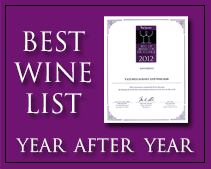Terms and jargons on whiskey or whisky
Date: 19th October, 2010
Manila Restaurant and Wine Bar discusses whiskey, scotch, single malt, Irish whiskey and Bourbon
Answers to common whisky terms
What is a single whisky?
A single whisky is the product of one particular distillery.
What is meant by saccharify?
To saccharify means to convert to sugar. In whisky distilling it refers to the process which takes place during the malting and mash-tun stages by which enzymes in the malt, referred to as diastase, turn the starch in the cereals into sugar ready for the fermenting action of the yeast.
What is diastase?
When conditions of temperature and moisture favour germination, the embryo and associated parts of the barley grain secrete a mixture of enzymes commonly known as diastase. These act to modify and make soluble the starch in the barley, thus preparing it for conversion at a later stage to maltose.
What is wort?
Wort is the liquid drawn off the mash-tun in which the malted and unmalted cereals have been mashed with warm water. Wort contains all the sugars of the malt and certain secondary constituents. After cooling, it is passed to the fermenting vats. In Malt distilleries the cereals are all malted; in Grain distilleries a proportion only is malted, the remainder being unmalted. In some cases, Grain distilleries do not separate off wort, passing the complete mash to the fermentation vessels.
What is wash?
The wort or mash technically becomes wash as soon as yeast is added to start fermentation. However, the term is usually used to refer to the liquid at the end of the fermentation. It is the wash which forms the raw material of the first distillation in the Pot Still process and of the only distillation in the Patent Still process.
What is the pot still distillation?
Malt Whisky is distilled twice – although a few distilleries may undertake a third distillation – in Pot Stills which resemble huge copper kettles.
The spirit is driven off from the fermented liquid as a vapour and then condensed back to a liquid.
In the first distillation the fermented liquid, or wash, is put into the Wash Still, which is heated either directly by fire or by steam-heated coils.
At this stage the wash contains yeast, crude alcohol, some unfermentable matter and the by-products of fermentation. During the process of boiling the wash, changes take place in its constituents which are vital to the flavour and character of the whisky.
As the wash boils, vapours pass up the neck of the still and then pass through a water-cooled condenser or a worm, a coiled copper pipe of decreasing diameter enclosed in a water jacket through which cold water circulates.
This condenses the vapours and the resulting distillate, known as low wines, is collected for re-distilling. The liquor remaining in the Wash Still is known as pot ale or burnt ale and is usually treated and converted into distillers’ solubles for animal feed.
The low wines are distilled again in the Spirit Still, similar in appearance and construction to the Wash Still but smaller because the bulk of liquid to be dealt with is less. Three fractions are obtained from the distillation in the Spirit Still. The first is termed foreshots, the second constitutes the potable spirit, and the third is called feints. The foreshots and feints are returned to the process and redistilled in the Spirit Still with the succeeding charge of low wines. The residue in the still, called spent lees, is run to waste.
In the case of the Spirit Still, the design of the still, the height of the head (or top) of the still and the angle of the wide-diameter pipe or lyne arm, connecting the head to the condensing unit, are all very important and have an effect on the distillate.
The Pot Still has changed little in general design over the centuries.
What is patent still distillation?
Unlike Malt Whisky, Grain Whisky is distilled in a continuous operation in a Patent Still. This is sometimes known as the Coffey Still, after Aeneas Coffey, who developed it in 1831.
Steam is fed into the base of the analyser and hot wash into the top. As the two meet on the surface of the perforated plates, the wash boils and a mixture of alcohol vapours and uncondensed steam rises to the top of the column. The spent wash runs down and is led off from the base.
The hot vapours enter the rectifier at the base and as they rise through the chambers they partially condense on the sections of a long coil through which wash is flowing. The spirit vapour condenses at the top of the rectifier and is run off through a water-cooled condenser to the spirit safe and on to the spirit receiver. Once the spirit begins to be collected it runs continuously until the end of distillation.
Because of the rectifying element present in this process the distillate is generally lighter in aroma than most Malt Whiskies. It consequently has a milder character and requires less time to mature.
What is the worm?
The worm and its surrounding bath of cold running water, or worm-tub, form together the condenser unit of the Pot Still process of manufacture. The worm itself is a coiled copper tube of decreasing diameter attached by the lyne arm to the head of the Pot Still and kept continuously cold by running water. In it the vapours from the still condense. Fed by the still, it in turn feeds the receiving vessel with the condensed distillate.
The worm is being replaced gradually by the more modern tubular condenser.
What are low wines?
This is the name given to the product of the first distillation in the Pot Still process of manufacture. It is the distillate derived from the wash and contains all the alcohol and secondary constituents and some water. It forms the raw material of the second distillation, which is carried out in the Spirit Still. The feints and foreshots are added to the low wines when the Spirit Still is charged.
What is pot ale?
Pot ale, alternatively burnt ale, is the liquor left in the Wash Still after the first distillation in the Pot Still process. It is the residue of the wash after the extraction by distillation of the low wines.
What are foreshots?
Foreshots is the term applied to the first fraction of the distillate received during the distillation of the low wines in the Spirit Still used in the Pot Still process of manufacture. They form the first raw runnings of this second distillation and their collection is terminated by the judgement of the stillman. The following fraction of the distillate is the potable spirit. The foreshots are returned to the still, together with the feints.
What are feints?
Feints is the name given to the third fraction of the distillate received from the second distillation in the Pot Still process. They form the undesirable last runnings of the distillation. As noted above, they are returned with the foreshots to the Spirit Still when it is recharged with low wines.
The term is also applied to the first and last runnings from the Patent Still, in which process they are returned to the wash for re-distillation.
The feints and foreshots from the last distillation of the season are kept for adding to the first low wines of the succeeding season.
What are spent lees?
Spent lees are the residue in the Spirit Still after the distillation of the foreshots, potable spirits, and feints. They are usually treated and run to waste.
What is draff?
Draff is the spent grain left in the mash-tun after the liquor, wort, has been drawn off. It represents, as a rule, about 25 per cent of the malt and unmalted cereals, if any, put into the mash-tun. Draff enjoys a large market as cattle food.
What are the principal by-products of Scotch Whisky?
The liquids and solids remaining after distillation are not wasted, nor are they allowed to pollute rivers or coastlines. In recent years the Scotch Whisky industry has invested heavily in developing methods of treating the residue of distillation so that it now makes an important contribution to the animal foodstuffs industry.
Most distilleries now possess by-products plants or, in the case of smaller distilleries in remote areas, send their waste material to the area plants which process it into dark grains. These are extremely rich in protein and are sold in palletised form to farmers who use them to enrich cattle food.
Grain Whisky distilleries usually recover the carbon dioxide produced during the fermentation stage. This has several applications in industry and in the production of soft drinks.
What is meant by Under Bond and Duty Paid sales, respectively?
(a) Sales Under Bond are sales on which the Excise Duty has not been paid. The goods are consigned to a bonded duty-free warehouse.
(b) Sales Duty Paid are sales on which the Excise Duty has already been paid.
Are these articles useful for enhancing your wine and dine experience in Manila and other cities like Pampanga Angles City, Subic and Clark Philippines. Do they also help you with travel, leisure, vacation, dining out, nightlife and other leisure activities plans in Philippines? Yats Restaurant hopes to supply you with plenty of information to plan out your trips from Manila to Pampanga Angeles City Clark Freeport Zone whether you are travelling from Manila or other Asian countries such as Hong Kong, Shanghai, Singapore, Malaysia or Korea.
Philippines Restaurant reservations in Manila, Subic, Pampanga Angles City or Clark Freeport Zone, planning of menu, selection of wine for dinner and booking a private function and nightlife and event in Angeles City Clark Freeport Zone can all be handled. Yats Restaurant and Wine Bar has been regarded by many to be the premier restaurant north of Manila Philippines. Its 3000-line award-winning restaurant wine list has kept many wine lovers happy dining in this restaurant in Pampanga Clark Philippines for over a decade.
Yats Restaurant and Wine Bar was built by Hong Kong-based Yats International in 2000 to provide a world-class fine dining restaurant, business meeting facilities and venues for private dinners and functions in Pampanga Angeles City Clark Freeport Zone. Pampanga Angeles City Clark Philippines was selected for this restaurant because of safety, clean air, absence of traffic and proximity to Manila and Subic.
For comments, inquiries and reservations, email Restaurant@Yats-International.com or call these numbers:
(045) 599-5600 0922-870-5178 0917-520-4401 ask for Ernest or Pedro.
Http://www.YatsRestaurant.com
Getting to this fine dining restaurant of Angeles City Clark Freeport Zone Pampanga Philippines
How to get to this fine-dining restaurant in Clark Philippines? Once you get to Clark Freeport, go straight until you hit Mimosa. After you enter Mimosa, stay on the left on Mimosa Drive, go past the Holiday Inn and Yats Restaurant (green top, independent 1-storey structure) is on your left. Just past the Yats Restaurant is the London Pub.
Source: http://www.whisky-heritage.co.uk/scotch-whisky/whisky-terms.php











